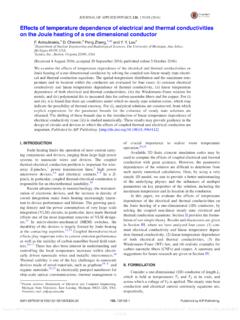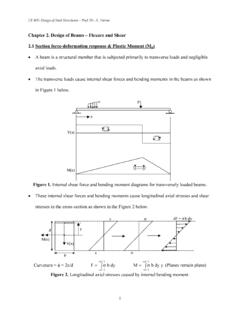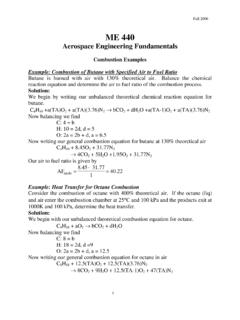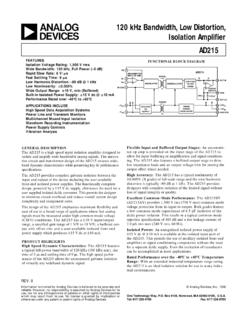Transcription of Biopotential Amplifiers - Michigan State University
1 Biopotential Amplifiers Basic function to increase the amplitude of a weak electric signal of biological origin (next slide) typically process voltages but in some cases also process currentsbut in some cases also process currents Typical bio-amp requirements high input impedance-greater than 10 Mohms safety: protect the organism being studied careful design to prevent macro and microshocks isolation and protection circuitry to limit the current through the electrode to safe level output impedanceof the amplifier should be low to drive any external load with minimal distortion gaingreater than 1000 gaingreater than 1000 biopotentials are typically less than a millivolt most Biopotential Amplifiers are differential signals are recorded using a bipolar electrodes which are symmetrically located high common mode rejectionratiogj biopotentials ride on a large offset signals rapid calibrationof the amplifier in laboratory conditions adjustable gains often the change in scale is automatic therefore calibration of the equipment is very importantBiopotential
2 Amplifiers . p. 1 ECE 445: Biomedical Instrumentation therefore calibration of the equipment is very importantVoltage and Frequency Range for BiopotentialsBiopotential Amplifiers . p. 2 ECE 445: Biomedical InstrumentationElectrocardiograph Amplifiers Beating heart generates electric signal monitored to understand heart functions Measurements are functions ofMeasurements are functions of location at which the signal is detected time-dependence of the signal amplitude Different pairs of electrodes at differentDifferent pairs of electrodes at different locations yield different measurements hence placement is standardized Electrical model of heart electric dipole located in a partially conducting medium (thorax) dipole represented as a cardiac vector MMi th di lt M is the dipole moment during the cardiac cycle magnitude and direction of the dipole vector will vary electric potentials appears throughout the body and Biopotential Amplifiers .
3 P. 3 ECE 445: Biomedical Instrumentatione ect c pote t a s appea s t oug out t e body a don its surface cos ,a11a1 MaM vvElectrocardiograph Leads In clinical electrocardiography more than one lead must be recorded to describe the heart's electric activity fully several leads are taken in the frontal plane several leads are taken in the frontal plane and the transverse plane frontal plane: parallel to the back when lying transverse plane: parallel to the ground when standingsta d g Frontal plane lead placement called Eindhoven s triangle Additional leadsAdditional leads unipolar measurements potential measured at electrodes wrt a reference; average of the 2 electrodes Wilson central terminal three limb electrodes connected through equal-valued resistors to a common node augmented leads some nodes disconnectedincrease the amplitude of measurement usingBiopotential Amplifiers .
4 P. 4 ECE 445: Biomedical Instrumentation increase the amplitude of measurement usingFunctional blocks of electrocardiographBiopotential Amplifiers . p. 5 ECE 445: Biomedical InstrumentationProblems in ECG Measurement Frequency distortion if filter specification does not match the frequency content of Biopotential then the result is high and low frequency distortiongqy Saturation or cutoff distortion high electrode offset voltage or improperly calibrated Amplifiers can drive the amplifier into saturationhh kffff then the peaks of QRS waveforms are cut off Ground loops if two monitoring instruments are placed at disjoint ground points then small current could flow through the patient sbody then small current could flow through the patient s body Electric/magnetic field coupling open lead wires (floating connections) pick up EMI long leads produce loop that picks up EMI (induces loop current)gpppp(p )
5 Interference from power lines (common mode interference) can couple onto ECG signalBiopotential Amplifiers . p. 6 ECE 445: Biomedical Instrumentation60Hz supply noiseCoupled to ECGI nterference Reduction TechniquesCommon-mode voltages can be responsible for much of the interference in Biopotential Amplifiers . Solution 1: amplifier with a very high common-mode rejection Solution 2: eliminate the source of interferencelfWays to eliminate interference Use shielding techniques electrostatic shielding: Place a grounded conducting plane between the source of the electric field and the measurement systemsource of the electric field and the measurement system very important for EEG measurement Magnetic shield use high permeability materials (sheet steel)Utitdblt dtifld ldlBiopotential Amplifiers .
6 P. 7 ECE 445: Biomedical Instrumentation Use twisted cables to reduce magnetic flux, reduce lead loop areaDifferential amplifier One-amp differential amplifier gain determination Rule 1: virtual short at op-amp inputs-Vini Rule 1: virtual short at op-amp inputs Rule 2: no current into op-amp+4345 RRRvvin 4o535 RvvRvviin Vin+43RR 43RR34o)(RRvvvinin RvGain of differential amplifier characteristicsVin-34oRRvvin Gain of differential amplifier (not gain of op-amp)= Gd no common mode gain, Gc = 1 input resistance of the diff. amp is lower than ideal op-amp OK for low resistance sources (like Wheatstone bridge), but not good for many biomedical applicationsGBiopotential Amplifiers . p. 8 ECE 445: Biomedical Instrumentationbiomedical applicationscommon mode rejection ratio:cdCMRRGG Differential amplifier How do we fix low input resistance of 1-op-amp diff amp?
7 Option 1: Add voltage follower to each input Option 1: Add voltage follower to each input Problem: ? Option 2: Add non-inverting amp at each input Option 2: Add noninverting amp at each input Provides additional gain Problem: ? Biopotential Amplifiers . p. 9 ECE 445: Biomedical InstrumentationInstrumentation amplifier Better option: connect Ri s of input amps together eliminate ground connection eliminate ground connection This 3-op-amp circuit is called an instrumentation amplifierInp t stage cha acte istics Input stage characteristics low common-mode gain -rejects common mode voltages (noise) high input impedanceittidjtdbR12432 RRvvG Biopotential Amplifiers . p. 10 ECE 445: Biomedical Instrumentation input stage gain adjusted by R11122143dRvvG Instrumentation amplifier Input stagegain stage Input stage high input impedance buffers gain stage no common mode gaininput stageg can have differential gain Gain stagedfflld differential gain, low input impedance Overall amplifier amplifies only the differential component 412d2 RRRG total differential gain amplifies only the differential component high common mode rejection ratio high input impedance suitable for Biopotential electrodes with high output impedance 31dRRGB iopotential Amplifiers .
8 P. 11 ECE 445: Biomedical InstrumentationppECG Amplifierinstrumentation amplifierWith 776 op amps, the circuit was found to have a CMRR of 86 dB at 100 Hz and a noise level of 40 mV peak tktthttThf004t150 H f3dB dfl t4t 40 HHPF non-inverting amp Biopotential Amplifiers . p. 12 ECE 445: Biomedical Instrumentationto peak at the output. The frequency response was Hz for 3 dB and was flat over 4 to 40 Hz. The total gain is 25 (instrument amp) x 32 (non-inverting amp) = 800. Driven Right Leg System Motivation reduce interference in amplifier improve patient safetyppy Approach patient right leg tied to output of an ilith thdauxiliary amp rather than ground common mode voltage on body sensed by averaging resistors, Ra s & fed back to right legto right leg provides negative feedback to reduce common mode voltage if high voltage appears between ti tddilipatient and ground, auxiliary amp effectively un-grounds the patient to stop current flowBiopotential Amplifiers .
9 P. 13 ECE 445: Biomedical InstrumentationDriven Right Leg System: Example Problem: Determine the common-mode voltage vcmon the patient in the driven-right-leg circuit of Slide 13 when a displacement current idflows to the patient from the power lines. Choose appropriate values for the resistances in the circuit so that the common-mode voltage is minimal and there is only a high-resistance path to ground when the auxiliary operational amplifier saturates. What isvcmfor this circuit when id= A? Answer: The equivalent circuit is shown here Note that because the common- Answer: The equivalent circuit is shown here. Note that because the common-mode gain of the input stage is 1, and because the input stage as shown has a very high input impedance, vcmat the input is isolated from the output circuit.
10 RRLrepresents the resistance of the right-leg electrode. Summing the currents at the negative input of the operational amplifier , we get this gives02foacm RvRv thus, substituting (1) into (2) yieldscmafo2vRRv odRLcmviRv but12dRLiRvBiopotential Amplifiers . p. 14 ECE 445: Biomedical InstrumentationafdRLcm/21 RRv Example continued The effective resistance between the right leg and ground is the resistance of the right-leg electrode divided by 1 plus the gain of the auxiliary operational- amplifier circuit. When the amplifier saturates, as would occur during a large transient vcm, its output appears as the saturation voltage vs. The right leg is now connected to pppgsggground through this source and the parallel resistances Rfand Ro. To limit the current, Rfand Ro should be large.











